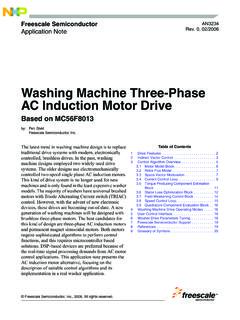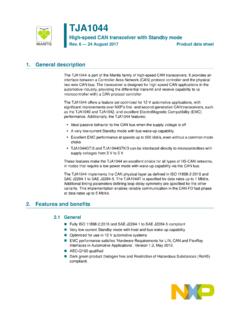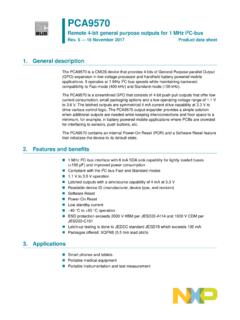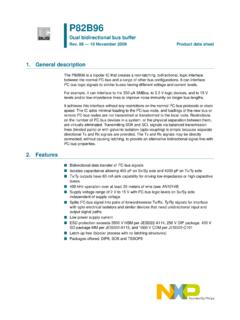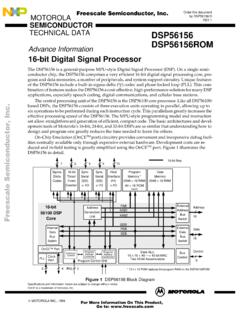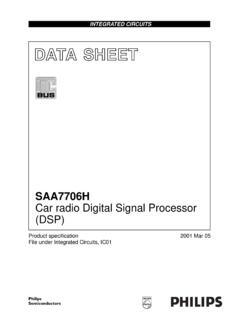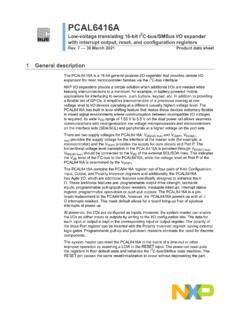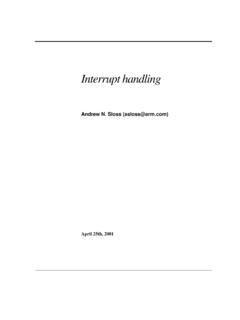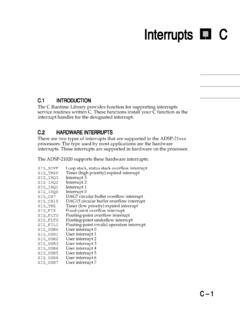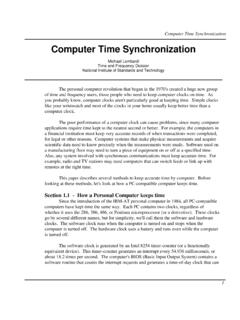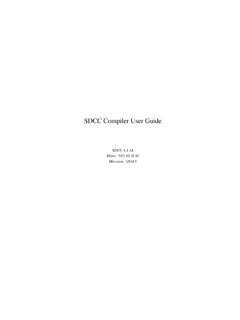Transcription of Measuring Interrupt Latency - NXP
1 NXP Semiconductors Document Number: AN12078. Application Note Rev. 1, 04/2018. Measuring Interrupt Latency 1. Introduction Contents The term Interrupt Latency refers to the delay between the start 1. Introduction .. 1. 2. Cause of Interrupt Latency .. 2. of an Interrupt Request (IRQ) and the start of the respective 3. RT1050 introduction .. 3. Interrupt Service Routine (ISR). The Interrupt Latency is 4. Arm Cortex-M Interrupt 3. expressed in core clock cycles. There is another exact 5. Measuring Interrupt Latency .. 4. Timer Interrupt 4. definition-the number of clock cycles from the assertion of the Timer Interrupt waking an RTOS task Latency .. 6. Interrupt request to the first ISR instruction executed, as shown GPIO Interrupt Latency .. 8. in Figure 1. 6. Conclusion .. 10. 7. Revision history .. 10. When the clock frequency is known, the Interrupt Latency is also expressed in terms of time (us or ns).
2 In some cases, there are broad sense definitions of the term to include more delay components. For example: The start point definition may be from the generation of the Interrupt signal, rather than the generation of the Interrupt request on the core. It may take several cycles for the Interrupt signal source to trigger the Interrupt request. The response point definition may be another event triggered by the ISR rather than the first instruction in the ISR, such as the response of an RTOS task woken up by the Interrupt . The Interrupt Latency is expected to be a known value and as short as possible, especially for applications with real-time requirements. However, it is always affected by many factors. 2018 NXP Cause of Interrupt Latency Figure 1. Definition of Interrupt Latency Normally, we can get the Interrupt Latency of a processor (core/CPU) from the specification which is defined by the designer, based on the processor architecture.
3 For a broad-sense definition of the Interrupt Latency of an actual MCU or MPU SoC platform, more additional influence factors make it difficult to provide an exact common value. On one hand, you can take all the influence factors into the account and calculate a theoretical value. On the other hand, you can observe the relevant signals on the pads of the platform with an oscilloscope, and ascertain the Interrupt Latency based on the measured data. This application note describes how to measure the Interrupt Latency of the RT1050 device. 2. Cause of Interrupt Latency The Interrupt Latency is usually affected by a lot of factors. For a narrow sense of the Interrupt Latency , there are these typical influence factors: For most processor architectures, the processor usually completes the current instruction, which may be a multi-cycle instruction. To save the current scene to restore the states when returning from the ISR, the processor pushes various necessary core registers (usually the program counter, flag registers, linker register, and so on) to the stack.
4 Some processor architectures need additional software statements to select the right ISR. Time to fetch and decode the ISR instructions to fill the pipeline. Most memory systems that store the code (such as flash) usually have wait states because the memory system clock frequency is usually much slower than the CPU clock. The Interrupt may be preempted by other higher-priority interrupts anytime, including before the first ISR instruction is executed. Measuring Interrupt Latency , Application Note, Rev. 1, 04/2018. 2 NXP Semiconductors Arm Cortex-M Interrupt Latency For a broad-sense definition of the Interrupt Latency , there are other additional factors: The Interrupt request signal must be synchronized to the CPU clock timing, which may take several cycles for the Interrupt signal source to trigger the Interrupt request. If the Interrupt request signal comes from outside of the processor device, the signal must be firstly synchronized to the bus/peripheral clock.
5 The RTOS may temporarily disable the interrupts when accessing critical resources. The Latency is longer if the Interrupt request asserts during the Interrupt is disabled. The response point may be defined as another event triggered by the ISR rather than the first instruction in the ISR, such as the response of an RTOS task which is blocked before and woken up by the Interrupt . It may take many cycles for the software to complete the process before the defined response point. 3. RT1050 introduction RT1050 is a processor family that features NXP's advanced implementation of the Arm Cortex - M7 core, which operates at speeds of up to 600 MHz to provide high CPU performance and the best real-time response. RT1050 has 512-KB on-chip RAM, which can be flexibly configured as Tightly-Coupled Memory (TCM) or general-purpose On-Chip RAM (OCRAM). It also provides interfaces to connect various external memories and a wide range of other communication interfaces, such as USB OTG, Ethernet, UART, I2C, SPI, and CAN.
6 It has rich audio and video features including the LCD display, basic 2D. graphics, camera interface, SPDIF, and I2S audio interface. Other notable features include various modules for security, motor control, analog signal processing, and power management. Reading the code/data from the RAM is optional to having no wait state (TCM only), or having an additional clock cycle that can avoid a potential timing problem caused by a relatively long memory access time at a high frequency. 4. Arm Cortex-M Interrupt Latency The Cortex-M processor closely integrates a configurable Nested Vectored Interrupt Controller (NVIC), providing a fast execution of ISRs. The Interrupt handlers do not require wrapping in code that removes any code overheads from the ISRs. The tail-chain, late-arrival, and pop-preemption mechanisms also significantly reduce the overhead when switching from one ISR to another.
7 The Cortex-M processor latencies are provided in Table 1. Table 1. Cortex-M Interrupt Latency Processors Cycles with zero wait states Cortex-M0 16. Cortex-M0+ 15. Cortex-M3/M4 12. Cortex-M7 10~12. The Interrupt Latency listed in Table 1 belongs to the narrow-sense definition and has the assumption that the memory system has zero wait states. Measuring Interrupt Latency , Application Note, Rev. 1, 04/2018. NXP Semiconductors 3. Measuring Interrupt Latency 5. Measuring Interrupt Latency This section describes how to measure the Interrupt Latency of the RT1050 MPU. There are three types of Latency that are measured: The Latency from the timer Interrupt to the ISR execution. The Latency from the timer Interrupt to the RTOS highest-priority task, which is woken up by the Interrupt and starts running. The Latency of the external GPIO Interrupt response. During the measurements, the Cortex-M7 core operates at 600 MHz, and the IPG clock runs at 150.
8 MHz. The code runs from the TCM with no wait states. Timer Interrupt Latency This type of Latency conforms to the narrow-sense definition (from the start of the IRQ to the start of the ISR), which is affected little by various hardware and software factors. The GPT1 (General Purpose Timer 1) on-chip timer module is configured to generate compare events on the compare channel1. A compare event simultaneously generates an output signal on the respective pad (GPT1_COMPARE1) and an Interrupt request on the NVIC. At the beginning of the GPT1 ISR, a GPIO pin (GPIO2-23) is toggled twice (firstly outputting high level, then outputting low level) to indicate the Interrupt event. The GPT1 ISR is shown in Example 1, and the assembly code to toggle the GPIO pin is shown in Example 2. Example 1. GPT1 ISR for timer Interrupt Latency measurement void GPT_IRQH andler(void). {. GPIO2->DR = 1u << 23.}
9 GPIO2->DR = 0u;. GPT_ClearStatusFlags(GPT_BASE, GPT_CHANNEL_FLAG);. }. Example 2. Instructions to toggle GPIO pin R0, [PC, #0x78] ; GPIO2_DR. R1, #8388608 ; 0x800000. STR R1, [R0]. MOVS R1, #0. STR R1, [R0]. As per Example 2, there are five instructions in total to toggle the GPIO twice: The first instruction (LDR) loads the GPIO data register's address to R0, which takes two cycles. The second instruction (MOV) fills R1 with the immediate data 8388608(1<<23), which takes one cycle. The third instruction (STR) updates the GPIO data register to generate the rising edge. The fourth instruction (MOVS) clears R1, which takes one cycle. Measuring Interrupt Latency , Application Note, Rev. 1, 04/2018. 4 NXP Semiconductors Measuring Interrupt Latency The fifth instruction (STR) updates the GPIO data register to generate the falling edge. Due to the low speed of the peripheral clock when compared to the core, there are wait states when the core accesses the GPIO data register.
10 Therefore, it is not known how much time it takes to complete the STR instruction in a glance like other instructions. You may observe the signals and determine the amount of clock cycles cost by the STR with a little trick. And that's why the GPIO pin is toggled twice. An oscilloscope is used to observe the GPT1_COMPARE1 and GPIO2_IO23 pads, as shown in Figure 2. Figure 2. Timer Interrupt waveforms There is a time delay between the rising edge of the timer compare output and the rising edge of the indicator GPIO output. However, this is not the definitive Interrupt Latency . It also includes some clock cycles taken by other instructions, as shown in Example 2. The signals' edges are quite gentle, which results from the capacitive components connected to the pads on the PCB. Based on the instructions shown in Example 2 and the wave form shown in Figure 2, you can draw the timing sequence diagram of the Interrupt process, as shown in Figure 3.

